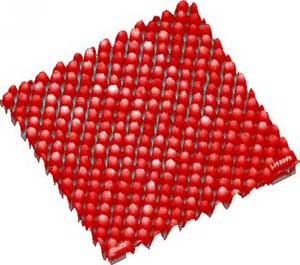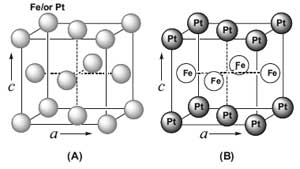| Posted: Feb 23, 2006 | |
Scientists are one step closer to advanced applications of magnetic FePt nanoparticles |
|
| (Nanowerk News) FePt nanoparticles containing a near-equal atomic percentage of iron and platinum are an important class of artificial nanostructured magnetic nanomaterials. They range in size from 2 to 20 nm in diameter and their magnetic properties change drastically with their size. | |
| In a recent review, Professor Shouheng Sun of the Chemistry Department at Brown University gives an overview of recent advances in chemical synthesis, self-assembly, and potential applications of monodisperse binary FePt nanoparticles. | |
| Sun is intruiged by the potential applications for these nanoparticles. "Research indicates that their structural and magnetic properties could lead to future applications in high-density data storage media, high-performance permanent magnetic nanocomposites and highly efficient and highly sensitive tools for bio-separation and bio-detection in biomedical applications" he told Nanowerk. | |
 |
Self-assembled 6 nm FePt nanocrystal array. (Source: Brown University) |
| There are still a few hurdles to making FePt nanomaterials into commercial and medical applications. Sun said that "studies have also revealed some problems associated with these FePt nanoparticle materials, which, if not solved, will likely limit their practicality." | |
| For instance, according to Sun, the as-synthesized FePt particles usually possess a chemically disordered fcc (face-centered cubic) structure. Thermal annealing is needed to convert the fcc structure to the highly anisotropic (directionally dependent) fct (face-centered tetragonal) structure and to transform the particles into room-temperature nanoscale ferromagnets. Although thermal annealing at high temperatures provide FePt nanoparticles with the desired magnetic properties, one serious side effect of this annealing is that the particles often sinter or react with the substrate. | |
 |
Schematic illustration of the unit cell of A) chemically disordered fcc and B) chemically ordered fct FePt. (Source: Brown University) |
| Recent experiments and computational models give rise to the hope that these hurdles can be overcome. "These findings indicate that the goal in fabrication of magnetically aligned FePt nanoparticle arrays is surely to be achieved in the near future" says Sun "and that detailed studies on nanomagnetism of these nanoparticles for advanced applications are then warranted." | |
| Professor Sun's article, titled "Recent Advances in Chemical Synthesis, Self-Assembly, and Applications of FePt Nanoparticles" was published in the Jan. 24, 2006 online edition of Avanced Materials. | |
 By
Michael
Berger
– Michael is author of three books by the Royal Society of Chemistry:
Nano-Society: Pushing the Boundaries of Technology,
Nanotechnology: The Future is Tiny, and
Nanoengineering: The Skills and Tools Making Technology Invisible
Copyright ©
Nanowerk LLC
By
Michael
Berger
– Michael is author of three books by the Royal Society of Chemistry:
Nano-Society: Pushing the Boundaries of Technology,
Nanotechnology: The Future is Tiny, and
Nanoengineering: The Skills and Tools Making Technology Invisible
Copyright ©
Nanowerk LLC
|
|
Become a Spotlight guest author! Join our large and growing group of guest contributors. Have you just published a scientific paper or have other exciting developments to share with the nanotechnology community? Here is how to publish on nanowerk.com.
